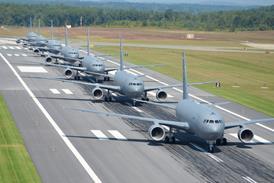GRAHAM WARWICK / WASHINGTON AND DEEDEE DOKE / AMSTERDAM
Boeing cuts staff by up to 30% but Airbus insists it can avoid reductions by holding back production
Boeing's decision to reduce the workforce at its Commercial Airplanes unit by 20-30% in response to the industry-wide capacity cuts by US airlines is certain to precipitate job cuts on a similar scale throughout its thousands of suppliers.
Tier one suppliers were holding internal studies and meetings with airlines last week and are expected to announce staff reductions this week. In Europe, Airbus was claiming it could avoid lay-offs by holding production at current levels.
"We were already anticipating a production downturn in the middle of 2002 because of the steep decline in aircraft orders before the attack. But it's happening now," says GE Aircraft Engines. Boeing has reduced its forecast for this year from 538 aircraft to "as low as 500 depending on customer ability to take delivery in the near term".
The delivery forecast for next year has been cut from 510-520 aircraft to the "low 400s", with a further reduction expected in 2003.
Although no US airline had officially announced the cancellation or deferral of orders as Flight International went to press, it appears Southwest Airlines is calling a halt to Boeing 737 deliveries this year, while some smaller carriers including American Trans Air and Hawaiian Airlines had stated they would continue to take delivery of new aircraft while grounding older types. Boeing Capital, meanwhile, is working with the major leasing companies on financing arrangements to help airlines take delivery of aircraft on order, says Commercial Airplanes chief executive Alan Mulally.
Boeing plans to lay off 20,000-30,000 of Commercial Airplanes' 96,600 workforce by the end of next year. Proportionate cuts are expected at engine manufacturers GE, Pratt & Whitney and Rolls-Royce, as well as major equipment suppliers like Goodrich and Honeywell. In addition to the cuts in new aircraft production, suppliers are likely to be hit by a drop in aftermarket business as airlines cut flying and retire older aircraft.
Where the axe will fall at Boeing has yet to be determined. The most drastic cuts are expected in 757 and 767 production. The 757-300 looks to be the most vulnerable, with Continental and Northwest accounting for 31 of the 42 aircraft on backlog. Rates on the 717 and 747 lines are also likely to come under scrutiny because of low backlogs, while the 737 and 777 could, potentially, remain relatively stable. Boeing and its major suppliers took a beating on the New York Stock Exchange last week, their share prices falling by around 30%. In contrast, companies with most of their business in the defence sector saw their shares rise - by over 30% in the case of Raytheon - in anticipation of increased US military spending.
Analysts expect Boeing's defence and space businesses to stop its stock falling much further. The US Aerospace Industries Association (AIA) expects commercial aircraft-related sales by its manufacturers to decline by $2 billion this year, with total industry sales now forecast at $143 billion - $400 million below last year's level. "Industry sales could decline by as much as $5.6 billion in 2002, and by $6.7 billion in 2003," says AIA president John Douglass.
In contrast, Airbus majority shareholder EADS announced on 20 September that the airframe builder plans to ward off layoffs stemming from the current aviation crisis but will restrict production levels to around 25 more than the 320 aircraft expected to be delivered this year. It had planned to increase production to 400 next year.
Since then, Lufthansa has announced it is not going ahead with an order for up to 15 A380s and BA has confirmed it is in discussions to defer A320 deliveries.
Source: Flight International























